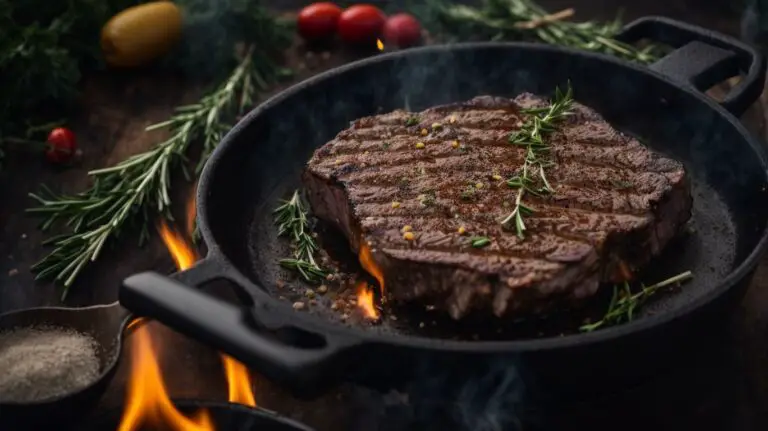How to Cook Meatballs After Freezing?
Have you ever wondered about the best way to freeze and cook meatballs?
We will explore everything you need to know about frozen meatballs – from why you should freeze them to the best containers for storing them.
Discover safe thawing methods, cooking techniques, and how to tell if your frozen meatballs are cooked to perfection.
Learn how to make delicious meatballs a convenient and tasty meal option!
Key Takeaways:
What Are Frozen Meatballs?
Frozen meatballs are pre-cooked or uncooked meatball mixture that has been frozen to extend its shelf life and retain freshness.
Pre-cooked frozen meatballs are essentially ready-to-eat, requiring minimal preparation time, often just needing to be heated. On the other hand, uncooked frozen meatballs need to be cooked thoroughly before consumption, allowing for flavor customization and preparation methods.
The freezing process involves quickly chilling the meatball mixture to very low temperatures, usually below zero degrees Fahrenheit, to prevent bacterial growth and preserve quality. Freezing meatballs not only extends their shelf life but also locks in their flavors, moisture, and nutrients, ensuring a convenient and versatile ingredient for various dishes.
Why Freeze Meatballs?
Freezing meatballs is a convenient way to preserve meatball mixture, extend its usability, and save time on meal preparation in the future.
When you prepare a batch of meatballs, freezing the excess portions allows you to have a quick and easy meal option readily available. This method not only reduces food waste but also ensures that you always have a flavorful dish at hand. Freezing uncooked meatballs helps in maintaining the integrity of the ingredients, preventing any spoilage and ensuring the freshness of the mixture.
How To Properly Freeze Meatballs?
Properly freezing meatballs involves shaping the raw meatball mixture, arranging them on a baking sheet, freezing until firm, then transferring them to freezer bags for long-term storage.
What Are The Best Containers For Freezing Meatballs?
The best containers for freezing meatballs are airtight freezer bags or containers that prevent freezer burn and maintain the quality of the meatball mixture.
Regarding freezer storage, airtight sealing is crucial to ensure that your meatballs remain fresh and flavorful. Freezer bags are a popular choice for their convenience and space-saving design. These durable bags not only prevent air from reaching the meatballs but also help in minimizing moisture loss, eliminating the risk of freezer burn. Freezer bags are versatile and easy to label, allowing for efficient organization in your freezer. If you prefer a more sustainable option, reusable containers made of high-quality plastic or glass can also offer excellent protection for your meatball mixture. Just make sure to leave some headspace to accommodate any potential expansion during freezing.
How To Label Frozen Meatballs?
Labeling frozen meatballs is essential for easy identification and usage, including information such as the date of freezing, type of meatball recipe, and whether they are cooked or uncooked.
When you meticulously label your frozen meatballs, it streamlines meal prepping and prevents any confusion. For instance, jotting down the freezing date helps you keep track of freshness and avoid any potential food wastage. Specifying the type of meatball recipe or the cooking status – whether they are already cooked or in a raw state – can significantly impact your meal planning process.
How To Thaw Frozen Meatballs?
Thawing frozen meatballs can be done safely in the refrigerator, microwave, or cold water, ensuring proper defrosting for subsequent cooking.
What Are The Safe Thawing Methods?
Safe thawing methods for frozen meatballs include refrigerator thawing for gradual defrosting, microwave thawing for quick preparation, and cold water thawing for immediate use in dishes like meatball soup.
When thawing frozen meatballs in the refrigerator, place them on a plate or in a container on the bottom shelf to prevent any drips or cross-contamination. This method allows the meatballs to defrost slowly and safely, preserving their quality and texture.
Cold water thawing can be done by submerging the sealed meatballs in a leak-proof bag in cold water, changing the water every 30 minutes to ensure a consistent temperature. For those looking for a speedy alternative, microwave thawing is convenient but requires caution to avoid cooking the meatballs unevenly.
How Long Does It Take To Thaw Frozen Meatballs?
The time it takes to thaw frozen meatballs depends on the method used, with refrigerator thawing typically requiring overnight, microwave thawing taking minutes, and cold water thawing varying based on meatball size.
When opting for refrigerator thawing, it is best to plan ahead and transfer the meatballs from the freezer to the refrigerator the night before you plan to use them. This gentle method allows the meatballs to thaw slowly and evenly, ensuring that they maintain their quality.
Conversely, if you’re short on time, the microwave provides a quicker solution. Remember to use the defrost setting and check the meatballs frequently to prevent any cooking on the edges.
Cold water thawing involves submerging the frozen meatballs in a sealed bag in a bowl of cold water. Change the water every 30 minutes if the meatballs are still partially frozen to expedite the process.
How To Cook Frozen Meatballs?

Credits: Poormet.Com – Bruce Lopez
Cooking frozen meatballs can be done using various methods such as simmering in tomato sauce for meatball subs or baking in the oven for a crispy texture.
What Are The Best Cooking Methods For Frozen Meatballs?
The best cooking methods for frozen meatballs include baking for Italian meatballs with garlic, simmering in sauces for added flavor, or using a slow cooker for convenient preparation.
When opting for baking, preheat the oven to the recommended temperature and arrange the meatballs evenly on a baking sheet. This method offers a crispy exterior and moist interior, perfect for Italian-style meatballs filled with robust garlic flavors.
Simmering frozen meatballs in a savory tomato sauce enhances the taste, as the juicy meatballs absorb the rich flavors of the sauce.
The slow cooker method requires minimal effort – simply place the frozen meatballs with your preferred seasonings and let the cooker gently infuse the garlic essence for a more indulgent dining experience.
Can You Cook Frozen Meatballs In The Microwave?
Cooking frozen meatballs in the microwave is possible for a quick meal solution, ensuring the meat is thoroughly cooked and heated before consumption.
If you decide to prepare frozen meatballs in the microwave, it’s important to follow some safety precautions to prevent any foodborne illnesses. Always start by checking the packaging instructions for specific microwave settings and times. Never use metal containers or foil as they can cause sparks and damage the microwave.
Cooking times for frozen meatballs can vary based on the microwave’s wattage level. It typically ranges from 3-5 minutes on high power for a handful of meatballs. For best results, rotate the meatballs halfway through cooking to ensure even heating.
Can You Cook Frozen Meatballs In The Oven?
Cooking frozen meatballs in the oven is a popular method for achieving a crispy exterior and even cooking, suitable for meatball mixtures containing beef, pork, or other meats.
When preparing frozen meatballs in the oven, preheat the oven to 350°F. This temperature provides a perfect balance, ensuring the meatballs are thoroughly cooked without burning the exterior. For beef meatballs, they usually require a slightly longer cooking time compared to pork or mixed meat variations.
Once the oven is preheated, place the frozen meatballs on a baking sheet lined with parchment paper or aluminum foil, ensuring they are spaced evenly to allow for proper airflow and cooking consistency.
Can You Cook Frozen Meatballs In The Slow Cooker?
Cooking frozen meatballs in the slow cooker is ideal for tenderizing meatball mixtures, enhancing flavors, and incorporating ingredients like turkey or dairy products for added richness.
One of the major benefits of using a slow cooker for frozen meatballs is the gradual cooking process, which allows flavors to meld together beautifully, resulting in a rich and delicious dish. The low and slow cooking method ensures that the meatballs stay tender and juicy, unlike traditional cooking methods that can sometimes lead to tough or dry meatballs. Slow cooking provides ample opportunity to experiment with different ingredients, such as various spices, herbs, and sauces, to create unique flavor profiles.
How To Tell If Frozen Meatballs Are Cooked?
Determining if frozen meatballs are fully cooked involves checking the internal temperature with a thermometer, ensuring it reaches the recommended level for safe consumption, or testing texture and appearance for cooked consistency.
Frequently Asked Questions
What is the best method for cooking meatballs after freezing?
The best method for cooking frozen meatballs is to bake them in the oven. This ensures that they cook evenly and retain their shape.
Can I thaw frozen meatballs before cooking?
Yes, you can thaw frozen meatballs before cooking them. Simply transfer them from the freezer to the refrigerator and let them thaw overnight.
How do I know when frozen meatballs are fully cooked?
The best way to determine if frozen meatballs are fully cooked is to use a meat thermometer. The internal temperature should reach 165°F (74°C).
Can I cook frozen meatballs in a slow cooker?
Yes, you can cook frozen meatballs in a slow cooker. However, it is recommended to cook them on low heat for a longer period of time to ensure they are fully cooked.
How long do I need to cook frozen meatballs in the oven?
Depending on the size of the meatballs, they should be cooked in the oven for 20-25 minutes at 375°F (190°C). It is important to check the internal temperature to ensure they are fully cooked.
What is the best way to store cooked meatballs after freezing?
Cooked meatballs can be stored in an airtight container in the freezer for up to 3 months. Make sure to label and date the container for easy identification.





